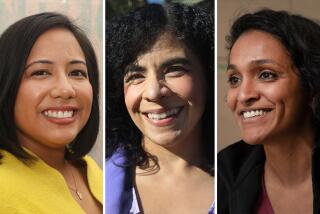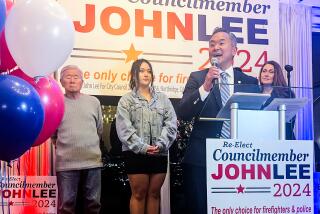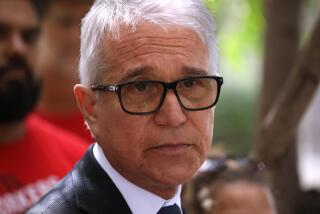Hahn Leads but Soboroff, Villaraigosa Narrow Gap
- Share via
Former legislator Antonio Villaraigosa and real estate broker Steve Soboroff have moved into contention in the race for mayor of Los Angeles, joining City Atty. James K. Hahn as the candidates most likely to secure one of the two positions in a runoff election, a Los Angeles Times poll has found.
The three candidates have pulled ahead of three other well-known challengers and the rest of the pack running for mayor, with the narrow margins between the three leaders promising a remarkably close contest in the election, which will be held one week from today.
Though Hahn still holds a narrow lead with 24% of likely voters, his support remains at a standstill since a Times poll a month ago. Villaraigosa and Soboroff, meanwhile, have gained ground on the city attorney. The poll found that Villaraigosa has the backing of 20% of likely voters and Soboroff 18%--both up from 12% a month ago.
The standings put the top three all well within striking range of one another--and within the poll’s margin of sampling error of plus or minus 3.5 percentage points.
“It looks like it’s down to a horse race between these three,” said Susan Pinkus, director of the Times Poll. “Villaraigosa and Soboroff have the momentum over Hahn, who is looking really stagnant. But it could be any two of these three in the runoff.”
The significant tightening of the race has been evident in the campaign for several days, as the once-restrained Hahn has pummeled Villaraigosa--criticizing the onetime speaker of the state Assembly for everything from the state electricity crisis to writing a letter on behalf of a convicted cocaine trafficker. Villaraigosa hit back at Hahn last week for the city attorney’s failure to do more to rein in police abuse.
The Republican Party has sent mailers on Soboroff’s behalf, taking aim at his principal rivals in the mayoral campaign, including Hahn and Villaraigosa.
The candidates’ standings with voters have solidified markedly since a month ago, when nearly a quarter of voters were undecided and many others were unsure of their choices. Now 15% of voters say they haven’t made up their minds, and nearly seven in 10 of those who have picked a candidate said they are certain of their vote.
Each of the candidates also brings a strong core group of constituents to his campaign: Hahn enjoys the strong support of African American voters; Soboroff’s backing is overwhelmingly white; and Villaraigosa has solid backing among Latinos and Jews.
Those findings and other dynamics appear to make three other candidates--City Councilman Joel Wachs, at 11%, state Controller Kathleen Connell at 6% and U.S. Rep. Xavier Becerra (D-Los Angeles) at 6%--longshots to find enough new supporters to make it into the June 5 runoff. All three have remained stagnant or fallen off from their already marginal showings of a month ago.
Aggressive Fund-Raising
In the most dynamic and closely fought mayoral contest in a generation, money has proved to be the lifeblood of the top candidates.
Hahn has raised the most money from campaign contributors and also benefits from several unions, which are contacting their members for him. Soboroff leads the overall financial derby, in large measure because he has injected $687,000 of his own money into the race. He also benefits from the California Republican Party’s multiple mailers. And Villaraigosa ranks just behind those two in fund-raising but gets a massive boost--perhaps $1.5 million worth of mailers, phone banks and organizers--from the state Democratic Party and the Los Angeles County Federation of Labor.
Those considerable advantages have helped the three front-runners piece together widely varying coalitions.
Hahn does best where his family has constructed an enduring political legacy: among African American voters in South Los Angeles. The city attorney also takes the biggest chunk of moderate voters.
The 63% of black voters supporting Hahn’s candidacy represent the closest thing to a lock on a single voter group in a race, where allegiances are widely diffused among the top contenders. With four terms at City Hall as city attorney, Hahn is one of the most recognized candidates in the field and enjoys the strongest approval rating; 67% of those polled have a favorable impression of him.
But despite Hahn’s five weeks of advertising about his record in office, many supporters continue to back him because he is the son of the late county supervisor, Kenneth Hahn, who represented South Los Angeles for 40 years.
“Kenneth Hahn was very good and helped the community out a whole lot,” poll respondent Nette Williams, a 37-year-old resident of South Los Angeles, said in a follow-up interview. “He had a multipurpose building here that provided a lot of services to the low-income community here. I am hoping the son will be a lot like the father.”
Hahn also benefits somewhat from a broader appeal among other ethnic groups and in other regions of the city. He does best among self-described moderates, capturing about one-third of those voters, double the support of his closest rival.
One of those middle-of-the-roaders is Ellie Lebowitz, 68, of Studio City. “He has had quite a few jobs in the government,” Lebowitz said of Hahn, “and I think he knows what he is doing.”
Villaraigosa Forges an Ethnic Coalition
Villaraigosa has become a contender because he appeals to liberal Democrats and Latinos, particularly in his home base on the Eastside, and also secures the biggest percentage of Jewish voters.
The liberal Jewish-ethnic alliance in some ways mirrors the coalitions that the late Mayor Tom Bradley assembled to win election five times in the 1970s and 1980s. The Villaraigosa variation replaces African American voters with Latinos.
The Mexican American native of City Terrace had lagged in second among Latinos a month ago, but now has pulled just barely ahead of Becerra among those voters. He has surged to a greater advantage among Jewish voters, capturing more than one-third of the vote--roughly double the backing received by each of the two Jews in the race, Soboroff and Wachs.
“It’s unification. It’s bringing together the public,” said Albert Lewis, 68, a self-described liberal who lives in Santa Monica Canyon. “People are divided along all sorts of lines and [Villaraigosa] looks like he would be able to pull the city together as much as it can be. And he did a real good job as speaker of the Assembly.”
There is a strong push among some union members and Latinos to get one of their own in the mayor’s office.
“He is a union man. That’s what I know,” Fred Ceja, 24, an apprentice electrician, said of Villaraigosa. Ceja received a mailer from his union, which persuaded him that Villaraigosa would be “looking out for the working people.”
Villaraigosa’s support from the county labor federation has helped him substantially in winning union households. But Hahn also has enough union backing that the two are in a virtual dead heat with that constituency.
Soboroff, in contrast, has started to draw together the white voters in the San Fernando Valley and on the Westside who helped elect Riordan twice. He leads in the Valley with one-quarter of the vote and also has about one-quarter of Westside voters, the same percentage that Villaraigosa draws from that part of the city.
The Republican businessman--who previously served as a recreation and parks commissioner for Riordan--dominates among GOP voters, particularly conservatives and men. Three out of five conservative Republicans said they plan to vote for Soboroff.
“I am pretty much a dyed in the wool Republican,” said Danny Crabb of Reseda, a manager for a Valley defense contractor, “I am up to my eyeballs in career politicians. I think it’s about time we got some fresh politics and it’s time we get someone like Soboroff, who hasn’t been making a living off it all of his life.”
If Soboroff can keep moving ahead and attain one of the two spots in the June runoff, he will need to make a substantially better showing among other ethnic groups to improve his chance of winning. About 83% of Soboroff’s supporters are white, with only single-digit backing from voters of other ethnic groups, the poll found.
A curious and ongoing phenomenon of the mayoral campaign continues to be the poor performance of Councilman Wachs--once seen as the election’s front-runner because of his high name identification and positive approval rating.
The 30-year lawmaker from Studio City has not moved at all since the Times Poll a month ago--with support from 11% of likely voters. That even lags behind his standing of a year ago, when 14% of registered voters backed him.
Wachs has depicted himself over the years as a watchdog for the taxpayers. His authorship of the city’s rent control law and utility price breaks was supposed to endear him to senior citizens. But the councilman trails the front-runners even among those who were supposed to be his core constituencies--Valley residents, Jews, conservatives and senior citizens.
The 62-year-old politician has also failed to keep up in fund-raising and has aired television ads that some professionals have criticized as lackluster.
Similarly, Connell has failed to parlay her years in state office or her status as the lone woman in the running into gains among voters. She trails the front-runners badly among women and even Democratic women, her most natural base of support.
For more than a week, Connell has tried another tactic. She has bombarded the TV airwaves with an ad saying she is the only candidate attending to the state’s energy crisis. Connell says she will protect customers of the Los Angeles Department of Water and Power from the outages and huge rate increases that have swept the rest of the state.
The Times Poll found that a significant number of Los Angeles voters over the past month have indeed come to believe that energy policy should be an issue of concern for the next mayor. But that shift in public opinion has not done much for Connell: Even among voters concerned about the energy crisis, Connell trails, with just 13% of the vote.
Bringing up the back of the pack with Connell is Becerra, who has been unable to raise enough money to mount a serious campaign on television or in the mail. He has mounted an extensive ground operation built on the work of volunteers, but he has failed to break out of his base audience of Latino voters on the Eastside.
More than three-quarters of Becerra’s backing comes from Latinos--second only to Soboroff in his campaign’s identity with a single ethnic group--but even some Latinos have left him in the last month.
“My preference was Xavier Becerra,” said Cecilia Santiago, 56, of Sun Valley. “But seeing that he just doesn’t have the popular appeal, I am going to support Villaraigosa.”
(BEGIN TEXT OF INFOBOX / INFOGRAPHIC)
Making Choices
* If the April 10 election for mayor were held today, for whom would you vote?
*--*
Now March 1 James K. Hahn 24% 24% Antonio Villaraigosa 20% 12% Steve Soboroff 18% 12% Joel Wachs 11% 11% Xavier Becerra 6% 10% Kathleen Connell 6% 8% Don’t know 15% 23%
*--*
*
* Are you certain that you’ll vote for that candidate? (Top three candidates shown)
*
*--*
Hahn Villaraigosa Soboroff voters voters voters Certain 62% 67% 71% Might vote for someone else 37% 32% 29% Don’t know 1% 1% --
*--*
*
* What do you think should be the next mayor’s top priority? (up to two replies accepted; top five responses shown)
*
Education: 42%
Crime/gangs: 25%
Police behavior: 20%
Energy crisis: 18%
Traffic congestion: 10%
*
* Mayor Richard Riordan has endorsed mayoral candidate Steve Soboroff. Does that make you more likely or less likely to vote for Soboroff for mayor?
*
*--*
All likely Soboroff voters voters More likely 14% 44% Less likely 20% 3% No effect 63% 53% Don’t know 3% --
*--*
*
* If the April 10 election for city attorney were held today, for whom would you vote?
Mike Feuer: 20%
Rocky Delgadillo: 15%
Lea Purwin D’Agostino: 12%
Frank Tavelman: 3%
Don’t know: 50%
*
* If the April 10 election for city controller were held today, for whom would you vote?
Laura Chick: 37%
Mervin L. Evans: 11%
Laurette Healey: 11%
Don’t know: 41%
*
Notes: All results shown are among likely voters. -- indicates less than 0.5%. Numbers may not total 100% where more than one response was accepted or some answer categories are not shown.
Times Poll results are also available at www.latimes.com/timespoll.
How the Poll Was Conducted
The Times Poll contacted 1,528 registered voters in the city of Los Angeles, including 769 likely voters, by telephone March 28-April 1. Likely voters were derived by assigning a score to questions asked of respondents about their voting history, intention to vote, interest in the election and whether they are first-time voters. Telephone numbers were chosen from a list of all exchanges in the city of Los Angeles. Random-digit dialing techniques were used so that listed and unlisted numbers could be contacted. The entire sample was weighted slightly to conform with census figures for sex, race, age, education and region. The margin of sampling error for likely voters is plus or minus 3.5 percentage points. Because the poll does not analyze any subgroup with fewer than 100 respondents, 346 African Americans and 592 Latinos were oversampled for the likely voter category. They were then weighted to their population size within the city. For certain subgroups the error margin may be somewhat higher. Poll results can also be affected by factors such as question wording and the order in which questions are presented. Interviews were conducted in English and Spanish. Asians were interviewed as part of the overall sample, but there were not enough to break out as a separate subgroup.
*
The Times Poll interviewed 769 likely voters by telephone March 28 through April 1.
More to Read
Sign up for Essential California
The most important California stories and recommendations in your inbox every morning.
You may occasionally receive promotional content from the Los Angeles Times.











